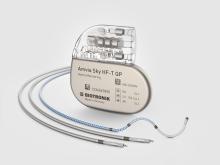In the first-in-human study BIOMAG-I, BIOTRONIK’s new-generation DREAMS 3G resorbable magnesium scaffold (RMS) showed significantly lower in-scaffold late lumen loss (LLL) than its predecessor at 12 months as well as excellent safety and efficacy. Prof. Michael Haude, BIOMAG-I Coordinating Clinical Investigator, presented the latest results in the late breaking trial session at the EuroPCR course.1 At one-year follow-up, BIOMAG-I data confirmed the excellent safety profile of DREAMS 3G RMS with a low target lesion failure rate of 2.6%. Neither cardiac death and myocardial infarction occurred, nor scaffold thrombosis was reported. After completion of the resorption, the in-scaffold LLL was 0.24±0.36 mm, comparable to contemporary drug-eluting stents (DES).2 “At the end of the scaffold resorption, at 12 months the data showed, that the DREAMS 3G scaffold has an excellent safety and efficacy profile”, said Prof Michael Haude, Rheinland Klinikum, Germany. “The late lumen loss is not just 38% better
BIOTRONIK announces the FDA 510(k) clearance and CE mark of its Oscar® (One Solution: Cross. Adjust. Restore) multifunctional peripheral catheter. Physicians in the U.S. have already used the novel device in more than 70 cases. As indicated per Instructions for Use, Oscar is intended for percutaneous transluminal interventions in the peripheral vasculature. The device was developed to provide support during access into and to dilate stenoses in femoral, popliteal and infrapopliteal arteries. The Oscar peripheral multifunctional catheter is comprised of three user-adjustable components: The Oscar system will be available in 11 total size configurations with either 0.014”/4F or 0.018”/6F guidewire/introducer sheath compatibility. This may massively reduce stock units required compared to a standard PTA balloon. Additional standalone Oscar PTA balloons are also available separately to be used with the Oscar support catheter. The Oscar support catheter and dilator are used in tandem to enable
BIOTRONIK is pleased to announce the availability of an expanded Maximum Allowed Diameters (MAD) range for the Orsiro® Mission Drug Eluting Stent (DES). Diameters 2.25mm to 3.00mm of the Orsiro Mission DES can now be extended up to 4.0mm, while diameters 3.5mm and 4.0mm can reach up to 5.0mm.This new MAD expansion follows the approvals from CE, FDA, and Health Canada obtained in the past months. This update reflects a global effort for the Orsiro Mission stent technology to match contemporary Percutaneous Coronary Intervention (PCI), enabling practitioners to optimize vessel apposition and conform to tapered anatomies.Subsequently to these approvals, an updated labelling, additionally to the modified Instructions for Use (IFU), will provide further guidance to practitioners.Always consult the Instructions for Use specific to your country when applying the Maximum Allowed Diameters (MAD).More information on Orsiro® Mission DES here.-END-Disclaimer: Orsiro and Orsiro Mission are trademarks or registered
Enitra 8 CRT pacemakers take CRT a step further than implantation and therapy, enabling unique patient care with full-body MR conditional, wireless systems supported by timesaving remote monitoring and unique physiological rate adaptation. For optimal support along the CRT healthcare journey, the Enitra 8 CRT-P series offers LV VectorOpt, BIOTRONIK Home Monitoring®, MRI AutoDetect and CLS. Empowering CRT — Unique Patient Care Opportunities Beyond Implantation and Therapy.
Evity 8 CRT pacemakers take CRT a step further than implantation and therapy, enabling unique patient care with full-body MR conditional, wireless systems supported by timesaving remote monitoring and unique physiological rate adaptation. For optimal support along the CRT healthcare journey, the Evity 8 CRT-P series offers LV VectorOpt, BIOTRONIK Home Monitoring®, MRI AutoDetect and CLS. Empowering CRT — Unique Patient Care Opportunities Beyond Implantation and Therapy.
New two-year follow-up data from the BIOMAG-I first-in-human trial confirms a reliable and predictable long-term safety profile for Freesolve™, the third-generation resorbable magnesium scaffold (RMS), establishing it as a true alternative to contemporary drug-eluting stents (DES). The results were presented by Prof. Dr. Michael Haude at the EuroPCR 2024 conference yesterday in Paris. At the 24-month follow-up, the incidence of target lesion failure (TLF) was 3.5% alongside a corresponding 3.5% incidence of target lesion revascularization (TLR) compares favorably with various second-generation DES. No cases of myocardial infarction (MI), cardiac death, or definite/probable scaffold thrombosis were reported.1 “At this two-year time point, the Freesolve RMS with its new Magnesium alloy which allows for increased radial strength, showed again excellent clinical and safety,” said Prof. Michael Haude, Rheinland Klinikum, Neuss, Germany. “With this highly competitive device, we're advancin
BIOTRONIK announced the presentation of the 12-month results from the BIONETIC-I study this week at LINC 2024.The prospective, international, multicenter single-arm observational study evaluated the treatment of de novo, restenotic or occluded iliac lesions in 160 patients with Rutherford Class 2-6 peripheral artery disease using the Dynetic®-35 cobalt chromium balloon-expandable stent system. At baseline, 12.5% of enrolled patients had critical limb ischemia, 90% had calcified lesions (30.7% severe calcification), and there was an average of 85.5% stenosis in the target lesion.The primary endpoint, major adverse events (MAE) at 12 months, was met with a 3.5% rate of MAE1, significantly non-inferior to the historical control threshold (14%). MAE included device- or procedure-related death within 30 days post-index procedure, clinically driven target lesion revascularization (cd-TLR) and major index limb amputation up to 12 months post-index procedure.At 12 months, freedom from cd-TLR was 98.0%, primary paten
BIOTRONIK, a global leader in cardiovascular, endovascular, and neuromodulation solutions, is pleased to announce today the approval of two new indications for the Orsiro® Mission Drug-Eluting Stent (DES): One-month Dual Antiplatelet Therapy (DAPT) for High Bleeding Risk (HBR) Patients: Allows practitioners to offer personalized, shorter DAPT durations to their patients at high risk of bleeding events, in accordance with the most recent guidelines. Calcified Lesions Treatment: Allows practitioners to target more complex lesions with moderate or severe calcification. These new indications complement the recent global regulatory approval of the Orsiro® Mission DES for an increased maximum allowed diameter (MAD) post-dilation (Ø2.25-3.0 mm, MAD: 4.0 mm, Ø3.5-4.0 mm, MAD: 5.0 mm). Following these approvals, labelling including adapted Instructions for Use will become effective in the coming months, pending further national regulatory approvals. Please refer to the Instruc
